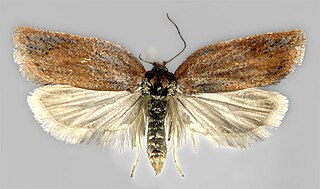
Acleris forsskaleana, the maple leaftier moth, is a moth of the family Tortricidae. It is found in Europe and North America in woodlands and gardens.

Acleris variegana, the garden rose tortricid moth or fruit tortricid, is a moth of the family Tortricidae. It has a Palearctic distribution. The moth flies from July to September mainly at night and is attracted to bright lights. The larvae feed on various trees and shrubs including rose and apple.

Aphelia viburnana, the bilberry tortrix, is a moth of the family Tortricidae. It is found in Europe, from Portugal and Great Britain to the Ural Mountains, Siberia and Mongolia, further east to the Russian Far East.

Aethes cnicana is a moth of the family Tortricidae. It was described by Westwood in 1854. It is found in Europe, China, Japan, Korea and Russia.

Acleris comariana, the strawberry tortrix, is a moth of the family Tortricidae. It is found in Europe, the Caucasus, Amur, Kamchatka, China, Korea and Japan.

Acleris rhombana, the rhomboid tortrix, is a moth of the family Tortricidae. It is found in the Palearctic realm, from Europe to the Caucasus, Armenia, and Turkmenistan.

Acleris emargana, the notched-winged tortricid, is a moth of the family Tortricidae. The species was first described by Johan Christian Fabricius in 1775.

Acleris hastiana is a moth of the family Tortricidae. It is found in Europe, northern Iran, Kazakhstan, Ala Tau, central Siberia, Irkutsk, the Amur region and China. In North America it is found from the north-eastern United States across southern Canada to British Columbia and south along the Pacific Coast to California.

Acleris rufana is a moth of the family Tortricidae. It is found from northern, central and south-western Europe through southern Siberia to the Russian Far East and Japan.

Acleris cristana, the rufous-margined button moth, is a moth of the family Tortricidae and is found from Europe through the Caucasus and Ussuri to Japan.

Acleris literana, the sprinkled rough-wing, is a moth of the family Tortricidae. The species was first described by Carl Linnaeus in his 1758 10th edition of Systema Naturae. It is found in most of Europe and in the Near East.

Acleris holmiana, the golden leafroller moth, is a moth of the family Tortricidae. It is found in most of Europe and Asia Minor.

Acleris ferrugana is a species of moth of the family Tortricidae. It is found in China, most of Europe and has also been recorded from North America.

Acleris bergmanniana, the yellow rose button moth, is a moth of the family Tortricidae. It is found from most of Europe to the eastern Palearctic realm.

Ancylis myrtillana is a moth of the family Tortricidae. It was described by Treitschke in 1830. It is found in most of Europe and across the Palearctic.It has also been recorded in North America. The habitat consists of moorland.

Acleris schalleriana, the viburnum button or Schaller's acleris moth, is a moth of the family Tortricidae. It was described by Carl Linnaeus in 1761. It is found in most of Europe. It is also found in North America. Acleris viburnana is a possible synonym that refers to the North American populations.
Acleris nigrilineana is a species of moth of the family Tortricidae. It is found in Korea, Japan, the Russian Far East and Denmark, Norway, Sweden, Finland, Poland, European Russia, Estonia and Latvia.

Acleris aspersana, the ginger button, is a species of moth of the family Tortricidae. It is found in Europe, where it has been recorded from Ireland, Great Britain, France, the Benelux, Germany, Denmark, Austria, Switzerland, Italy, the Czech Republic, Slovakia, Slovenia, Croatia, Hungary, Bulgaria, Romania, Poland, Norway, Sweden, Finland, the Baltic region and Russia. It is also found in the Near East and the eastern Palearctic realm. Their habitat consists of meadows and forest edges.

Acleris caledoniana, the Caledonian button, is a species of moth of the family Tortricidae. It is found in Ireland, Great Britain and Poland. It is found in high moorland, where it inhabits mountain bogs.

Acleris permutana is a species of moth of the family Tortricidae. It is found in Ireland, Great Britain, Portugal, Spain, France, Belgium, the Netherlands, Germany, Denmark, Sweden, Austria, Italy, the Czech Republic, Slovakia, Slovenia, Croatia, Hungary, Romania, North Macedonia and Russia. The habitat consists of coastal sandhills and limestone.




















